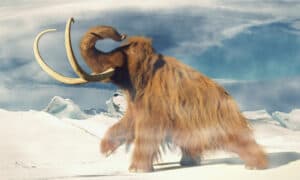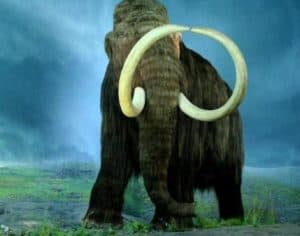Picture this: snow dusts the ground of a vast plain. Mountains rise in the distance, powerful winds sweep chilly air from the North Pole across the tundra, the very earth beneath your feet is frozen solid. Only the hardiest creatures survive this environment. In your periphery, a great beast trundles. It stands twelve feet tall, its elephantine body covered in fur. Great, ivory tusks extend nine feet from its skull.
The woolly mammoth.
You stand in the distant past, right? Well, if one ambitious start-up manages to accomplish its goal, the woolly mammoth may return in the near future.
Colossal, the company founded by biologist George Church, seeks to resurrect the woolly mammoth before the end of the decade. By using revolutionary modern technology, they hope to repopulate the Siberian tundra mammoths by the year 2027.
How to Resurrect the Extinct Woolly Mammoth
Church works as a geneticist at Harvard University, where he spearheaded the preliminary effort. Along with a team of other biologists and geneticists, they laid the groundwork for the woolly’s return. After a recent infusion of cash, $15 million raised from investors, they plan to forge ahead with their innovative and groundbreaking work.
It involves the use of a recently developed technology known as CRISPR — clustered regularly interspaced short palindromic repeats. In a nutshell, it allows scientists to edit genomes. By using this tool, Church and his team seek to recreate the woolly mammoth by manipulating the genome of a modern Asian elephant.
Because the Asian elephant and the woolly mammoth share a common ancestor dating back six million years, there remain enough similarities between their genomes to change one into the other. With genetic samples from woolly mammoths that were found well preserved in ice, the scientists have an excellent guide to begin.
By changing certain aspects of the Asian elephant, they intend to produce a creature more closely resembling the woolly mammoth. Technically, it won’t be a perfect recreation, but rather a well-constructed simulacrum. They will splice in thicker hair, added fat, and other woolly mammoth traits into the elephant’s genome to arrive at an animal proximal to the woolly mammoth.
In an interview with the Guardian’s Ian Sample, Church said, “Not because we are trying to trick anybody, but because we want something that is functionally equivalent to the mammoth, that will enjoy its time at -40 Celsius.”
Is it Ethical to Resurrect the Woolly Mammoth?
Some have raised concerns over the news of Colossal’s intention to bring back the long extinct animal. Despite all the research and information gathered, much remains unknown about the woolly mammoth. The species mostly died out over ten thousand years ago as a result of human predators and a warming climate. The last of their kind hobbled a few more thousand years, sequestered on islands in the Arctic Ocean, but completely died off around 4,000 years ago.
As a result, mysteries abound. No one knows exactly how woolly mammoths behaved and, although samples shed light on their biology, the picture remains incomplete.
Many scientists have raised concerns over the preceding decade regarding the resurrection of extinct species. Ecosystems construct themselves over hundreds of years, forging a balance between all participating species of animal and plant life. Throwing a new animal into the mix can have (and has had) disastrous results. Just ask the dodo bird.
However, Church defends his position stating the return of the woolly mammoth actually brings environmental benefits. Moss now dominates the tundra, whereas during the woolly mammoth’s reign, it was a thriving grassland. Church contends the woolly mammoth contributed to the management of its ecosystem through its eating habits and fertilizing the land with its scat.
Russian ecologists already employ a similar method by introducing large numbers of bison to the tundra in the hope their population changes the mossy tundra back into a grassland.
Yet, others remain skeptical. Love Dalén, a paleontologists working Centre for Palaeogenetics in Stockholm, said to CNN, “There’s absolutely nothing that says that putting mammoths out there will have any, any effect on climate change whatsoever.”
Many hurdles remain, however, before Church and his team actually birth a living woolly mammoth. They still need to harvest eggs from female Asian elephants, a feat never previously accomplished. Then, Church has decided to construct an artificial uterus rather than use surrogate elephant mothers — a rather tricky feat in its own right. Scientists managed to create a false uterus that supports lamb fetuses up to four weeks at the Children’s Hospital of Philadelphia.
Church and his team need one that supports a 200 pound fetus for up to two years.
So Will We See Woolly Mammoth Walk the Earth Again?
At present, the question remains unanswered. Too many scientific hurdles remain to definitely say whether Church will be successful. And then, of course, there are the governmental hurdles beyond that. Resurrecting the woolly mammoth by 2027 might sound flashy enough to garner interest from investors with deep pockets, but could prove harder than Church lets on.
FAQs
What did woolly mammoths eat?
Despite their formidable size and menacing tusks, woolly mammoths actually subsisted entirely on grass. They were strictly herbivores.
Where did woolly mammoths live?
The woolly mammoth, equipped for sub-zero temperatures, thrived in the Arctic tundra. However, after warming and predation dwindled their numbers, a subset lived out their remaining millenia on islands in the Arctic Ocean, such as Wrangel Island.
Are there other animals going through de-extinction?
While none have actually been resurrected, the development of new technologies continue to push the debate over whether to return extinct species. Animals such as the passenger pigeon, the thylacine (more commonly known as the tasmanian tiger), and auroch, a type of large cattle, have been presented as potential candidates.
The photo featured at the top of this post is © Dotted Yeti/Shutterstock.com
Thank you for reading! Have some feedback for us? Contact the AZ Animals editorial team.





